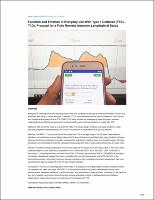Please use this identifier to cite or link to this item:
https://hdl.handle.net/20.500.12202/9365| Title: | Function and emotion in everyday life with type 1 diabetes (feelt1d): Protocol for a fully remote intensive longitudinal study |
| Authors: | Pyatak, Elizabeth Ann Hernandez, Raymond Pham, Loree T Mehdiyeva, Khatira Schneider, Stefan Peters, Anne Ruelas, Valerie Crandall, Jill Lee, Pey-Jiuan Jin, Haomiao Hoogendoorn, Claire J Crespo-Ramos, Gladys Mendez-Rodriguez, Heidy Harmel, Mark Walker, Martha Serafin-Dokhan, Sara Gonzalez, Jeffrey S Spruijt-Metz, Donna |
| Keywords: | ecological momentary assessments type 1 diabetes (T1D) patient-centered outcomes research actigraphy ambulatory monitoring continuous glucose monitoring EMA diabetes patient-centered outcome outcome monitoring function emotion longitudinal well-being |
| Issue Date: | 2021 |
| Publisher: | JMIR Publications |
| Citation: | Pyatak, E. A., Hernandez, R., Pham, L. T., Mehdiyeva, K., Schneider, S., Peters, A., Ruelas, V., Crandall, J., Lee, P.-J., Jin, H., Hoogendoorn, C. J., Crespo-Ramos, G., Mendez-Rodriguez, H., Harmel, M., Walker, M., Serafin-Dokhan, S., Gonzalez, J. S., & Spruijt-Metz, D. (2021).Function and emotion in everyday life with type 1 diabetes (feelt1d): Protocol for a fully remote intensive longitudinal study. JMIR Research Protocols, 10(10), e30901. https://doi.org/10.2196/30901 |
| Series/Report no.: | JMIR Research Protocols;10(10) |
| Abstract: | Abstract Background: Although short-term blood glucose levels and variability are thought to underlie diminished function and emotional well-being in people with type 1 diabetes (T1D), these relationships are poorly understood. The Function and Emotion in Everyday Life with T1D (FEEL-T1D) study focuses on investigating these short-term dynamic relationships among blood glucose levels, functional ability, and emotional well-being in adults with T1D. Objective: The aim of this study is to present the FEEL-T1D study design, methods, and study progress to date, including adaptations necessitated by the COVID-19 pandemic to implement the study fully remotely. Methods: The FEEL-T1D study will recruit 200 adults with T1D in the age range of 18-75 years. Data collection includes a comprehensive survey battery, along with 14 days of intensive longitudinal data using blinded continuous glucose monitoring, ecological momentary assessments, ambulatory cognitive tasks, and accelerometers. All study procedures are conducted remotely by mailing the study equipment and by using videoconferencing for study visits. Results: The study received institutional review board approval in January 2019 and was funded in April 2019. Data collection began in June 2020 and is projected to end in December 2021. As of June 2021, after 12 months of recruitment, 124 participants have enrolled in the FEEL-T1D study. Approximately 87.6% (7082/8087) of ecological momentary assessment surveys have been completed with minimal missing data, and 82.0% (82/100) of the participants provided concurrent continuous glucose monitoring data, ecological momentary assessment data, and accelerometer data for at least 10 of the 14 days of data collection. Conclusions: Thus far, our reconfiguration of the FEEL-T1D protocol to be implemented remotely during the COVID-19 pandemic has been a success. The FEEL-T1D study will elucidate the dynamic relationships among blood glucose levels, emotional well-being, cognitive function, and participation in daily activities. In doing so, it will pave the way for innovative just-in-time interventions and produce actionable insights to facilitate tailoring of diabetes treatments to optimize the function and well-being of individuals with T1D. |
| Description: | Scholarly article / Open access |
| URI: | https://www.researchprotocols.org/2021/10/e30901 https://hdl.handle.net/20.500.12202/9365 |
| ISSN: | ISSN: 1929-074 |
| Appears in Collections: | Ferkauf Graduate School of Psychology: Faculty Publications |
Files in This Item:
| File | Description | Size | Format | |
|---|---|---|---|---|
| Gonzalez 2021 researchprotocols.org-Function and Emotion in Everyday Life OA.pdf | 444.51 kB | Adobe PDF |  View/Open |
This item is licensed under a Creative Commons License

